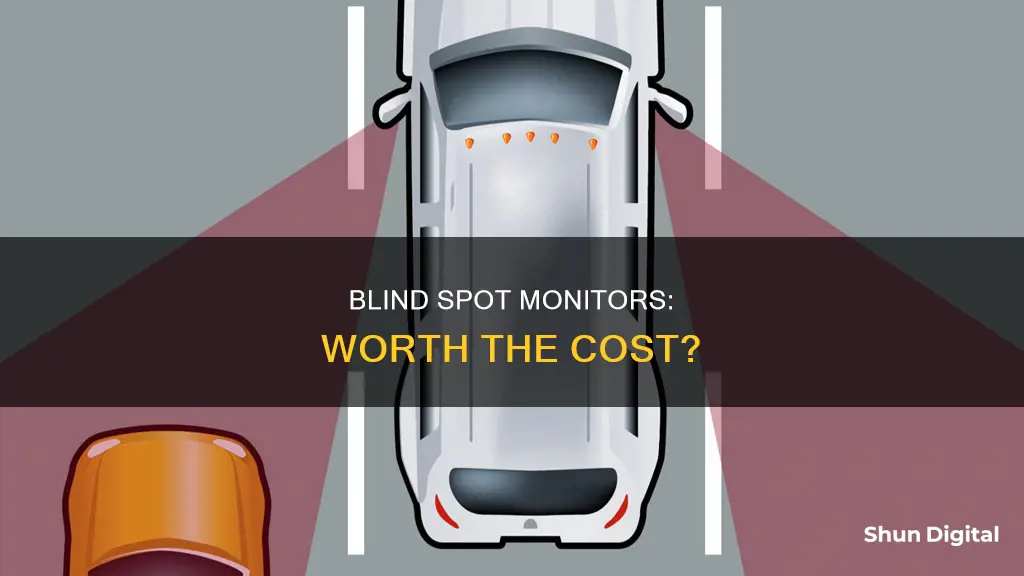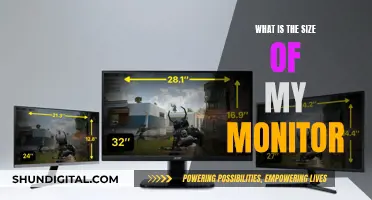
Blind spot monitors are safety features in cars that can detect when another vehicle is in your blind spot. They are not yet required, but they can be helpful in preventing crashes. Blind spot crashes are one of the most common types of auto accidents, with more than 800,000 blind spot accidents occurring each year in the US. Blind spot monitors use sensors in a vehicle's rear bumper and/or side mirrors to detect when another vehicle is approaching and alert the driver through an indicator light and/or a warning chime. While these systems are not 100% effective 100% of the time, studies have shown that they can significantly reduce the risk of injury-causing crashes.
| Characteristics | Values |
|---|---|
| Use case | Some people think that blind spot monitors are unnecessary because they believe that drivers should be checking their mirrors and surroundings when driving. |
| Effectiveness | Blind spot monitoring systems are effective at reducing crashes. According to the Insurance Institute for Highway Safety, cars with blind spot monitoring systems are 23% less likely to get into injury-causing crashes. However, they are not 100% effective 100% of the time. They usually have minimum and maximum speed limits for detection. |
| Drawbacks | Blind spot monitors can struggle to detect vehicles smaller than cars, such as motorcycles. They also have difficulty detecting fast-moving vehicles. |
| Best practices | Blind spot monitoring is a useful feature, but drivers should still check their blind spots when changing lanes or turning. |
What You'll Learn
- Blind spot monitors are not a substitute for checking mirrors or looking over your shoulder
- Blind spot monitors are not 100% effective 100% of the time
- Blind spot monitors struggle to detect motorcycles
- Blind spot monitors are a useful safety feature
- Blind spot monitors are now available on a wider range of vehicles

Blind spot monitors are not a substitute for checking mirrors or looking over your shoulder
Blind spot monitors are a useful tool to have in your car, but they are not a substitute for checking mirrors or physically looking over your shoulder. They are designed to be supplementary to these actions, not a replacement.
Blind spot monitors are safety features in cars that can detect when another vehicle is in your blind spot. They use sensors in a vehicle's rear bumper and/or side mirrors to detect when another vehicle is approaching and from which side. When the system detects a vehicle, it will alert the driver via an audible or visual warning. This is usually an indicator light with a warning chime.
While blind spot monitors are a helpful tool, they are not 100% effective 100% of the time. They often have minimum and maximum speed limits for detection, and can struggle to detect vehicles that are smaller than cars, such as motorcycles. Additionally, the driver's ability to notice the warning signal can be affected by outside circumstances, such as bright lights.
Therefore, it is important for drivers to still check their mirrors and look over their shoulder before changing lanes or merging, even if they have a blind spot monitor in their vehicle. Drivers are still liable for blind spot crashes, even if they have a blind spot monitor installed. While the monitor can help to prevent crashes, it should not be solely relied upon.
In conclusion, while blind spot monitors are a valuable safety feature, they should not be seen as a substitute for checking mirrors or looking over your shoulder. They are designed to be used in conjunction with these actions to help improve safety on the road.
Monitor Calibrator Returns: Ethical or Not?
You may want to see also

Blind spot monitors are not 100% effective 100% of the time
Blind spot monitors are not always reliable. Electronics can fail, and drivers should not rely on them entirely. They are meant to be used in conjunction with good driving practices, such as checking your blind spot and using your mirrors.
Additionally, blind spot monitors have some limitations. They usually have a minimum and maximum speed that they can detect other vehicles approaching at, which means they are generally only useful on the highway. They also have difficulty detecting vehicles that are smaller than cars, such as motorcycles, and may not be able to detect them in time to prevent an accident.
Furthermore, the effectiveness of blind spot monitors depends on the driver's ability to notice the warnings. Visual warnings on the side mirrors or instrument panel may be difficult for the driver to see, especially if they are not in their direct line of sight. Audio warnings may also be missed if they are too quiet or if there is a lot of noise in the car.
In conclusion, while blind spot monitors are a valuable safety feature, they are not perfect and should be used in combination with proper driving techniques to ensure the safest driving experience.
Signs It's Time to Upgrade Your Monitor
You may want to see also

Blind spot monitors struggle to detect motorcycles
Blind spot monitors are safety features in cars that can detect when another vehicle is in your blind spot. They are designed to help prevent one of the most common types of auto accidents: blind spot crashes. While they are not yet required, they can be helpful in preventing crashes.
However, blind spot monitors are not 100% effective 100% of the time. They often struggle to detect vehicles smaller than cars, which means they have difficulty detecting motorcycles. According to the American Automobile Association (AAA), blind spot monitors need 26% more time to determine if a motorcycle is in a blind spot than they do for a car. This delay can cause issues when merging onto a busy highway, and it means that if a driver is not waiting long enough for the blind spot monitor to read the area around the car before changing lanes, the monitor may not be useful.
Motorcycle helmets also make it more challenging for bikers to look left, right, and rear without taking their eyes off the road. This makes it physically impossible for them to monitor the rear portion of the road and lower peripheral sides. These areas are known as "blind spots" or "no zones". Taking your eyes off the road to monitor your blind spots can have devastating results.
To address this issue, some companies have developed motorcycle blind spot detection systems. These systems use a radar or sensor mounted on the rear of the bike to detect vehicles in adjacent lanes. The system then triggers an alarm that alerts the rider, allowing them to take any necessary preventive measures. These systems can provide early detection and warning, lane change assistance, and a broad detection area. They can also be useful in bad weather conditions, where visibility is reduced.
Determining the Age of Your Savannah Monitor
You may want to see also

Blind spot monitors are a useful safety feature
According to the Insurance Institute for Highway Safety, cars equipped with blind spot monitoring systems are 23% less likely to be involved in injury-causing crashes. This equates to a potential 50,000 crashes and 16,000 injuries prevented annually if all vehicles were fitted with such technology.
While blind spot monitors are not mandatory, they are becoming increasingly common, with many automakers offering them as standard or optional features, even on non-luxury vehicles. They are particularly useful for larger vehicles like SUVs, which tend to have larger blind spots than smaller cars.
Some drawbacks of blind spot monitors include their inability to detect fast-moving vehicles effectively, potential delays in alerting the driver, and struggles with detecting smaller vehicles like motorcycles. Additionally, they should be used as a supplementary tool, as drivers are still liable for accidents even with blind spot monitors installed.
Despite these limitations, blind spot monitors can provide valuable assistance and improve safety, especially when used in conjunction with proper mirror adjustment and driving practices. They are a welcome addition to the arsenal of safety features available to modern drivers.
Connecting Your Acer Monitor to a MacBook Pro
You may want to see also

Blind spot monitors are now available on a wider range of vehicles
The Insurance Institute for Highway Safety found that cars with blind spot monitoring systems are 23% less likely to be involved in injury-causing crashes. This equates to a potential 50,000 crashes and 16,000 injuries prevented annually if all vehicles were equipped with these systems. Additionally, studies have shown that lane-change collision rates drop by 14% with vehicles that have blind-spot monitoring active compared to those without.
While blind spot monitors are not mandatory like backup cameras, they are becoming increasingly common in new vehicles. Automakers such as Toyota, Lexus, Nissan, Ford, Tesla, Audi, and BMW offer blind-spot monitoring systems, often bundled with other active safety technologies. However, some automakers restrict these features to upper trims or more expensive vehicles.
Despite the benefits of blind spot monitoring, it is important to note that these systems are not perfect. They have difficulty detecting fast-moving vehicles and motorcycles, and may not always provide alerts in time for the driver to take action. Additionally, they are meant to supplement, not replace, the driver's responsibility to check mirrors and surroundings before changing lanes.
Overall, blind spot monitoring is a valuable safety feature that can help reduce the risk of accidents, especially when used in conjunction with safe driving practices. As the technology continues to advance and become more widely available, it is likely that we will see even further improvements in road safety.
Monitor Internet Speed: Track Usage in Real-Time
You may want to see also
Frequently asked questions
A blind spot monitor is a safety feature in cars that can detect when another vehicle is in your blind spot. The areas around your car that are not visible from your side-view or rear-view mirrors, such as immediately behind the driver’s side and front passenger windows, are known as “blind spots.” Blind spot monitors use sensors in a vehicle’s rear bumper and/or side mirrors to detect when another vehicle is approaching and from which side.
According to the Insurance Institute for Highway Safety, cars with blind spot monitoring systems are 23% less likely to get into injury-causing crashes. The research suggests if all vehicles were equipped with blind spot monitors, 50,000 crashes and 16,000 injuries could be prevented every year. However, they are not 100% effective 100% of the time. They usually have minimum and maximum speed limits for detection and struggle to detect vehicles smaller than cars, such as motorcycles.
The biggest issue is the ability of the technology to detect fast-moving vehicles efficiently. Alerts would often be provided too late for the driver to take action. Since most blind-spot monitoring systems work on visual cues on the driver’s side mirror, it may be difficult for the driver to pick up in time.
While the specifics can vary from manufacturer to manufacturer, there are two common types of blind-spot detection systems. Blind Spot Warning (BSW) is the most common type of blind-spot monitoring available on the market. A BSW will alert drivers via an audible or visual warning that a car is currently in its blind spot. The second type of system is Blind Spot Warning with Automatic Emergency Steering, which does the same thing as a BSW but contains an extra feature that will automatically steer or brake if the driver changes lanes when a vehicle is in its blind spot.
Blind spot monitoring is one of the most useful tools for keeping safe. If you pay attention to the audible or visual warnings, they can minimize your chances of merging into another vehicle. However, they are not a substitute for checking your mirrors or looking over your shoulder before changing lanes or merging. Blind spot monitors are supposed to be supplemental. Systems with collision prevention functionality add further value to blind-spot monitoring because they actively steer or brake, adding another layer of security during your drive.







